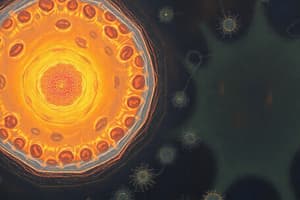Podcast
Questions and Answers
Which of the following characteristics is exclusive to eukaryotic cells?
Which of the following characteristics is exclusive to eukaryotic cells?
- Presence of a membrane-bound nucleus (correct)
- Presence of ribosomes
- Ability to reproduce
- Use of lipids as building blocks
Which of the following is a primary difference in the genetic structure of prokaryotic and eukaryotic cells?
Which of the following is a primary difference in the genetic structure of prokaryotic and eukaryotic cells?
- Eukaryotes have single circular chromosomes, while prokaryotes have paired chromosomes.
- Prokaryotes have linear chromosomes, while eukaryotes have circular chromosomes.
- Eukaryotes have paired chromosomes contained within a nucleus, whereas prokaryotes typically have a single circular chromosome located in a nucleoid region. (correct)
- Prokaryotes have more complex DNA structures than eukaryotes.
What is the significance of the presence or absence of sterols in the plasma membrane when comparing prokaryotic and eukaryotic cells?
What is the significance of the presence or absence of sterols in the plasma membrane when comparing prokaryotic and eukaryotic cells?
- Eukaryotic cells have sterols in their plasma membrane, which is absent in prokaryotes. (correct)
- Both prokaryotic and eukaryotic cells have sterols in their plasma membrane, but in different concentrations.
- Sterols are found in the plasma membrane of prokaryotes, providing rigidity.
- Sterols are present in both, providing flexibility
How do the ribosomes in prokaryotic and eukaryotic cells differ?
How do the ribosomes in prokaryotic and eukaryotic cells differ?
What is the key functional difference between the extracellular structures of prokaryotic and eukaryotic cells?
What is the key functional difference between the extracellular structures of prokaryotic and eukaryotic cells?
Which process is exclusive to eukaryotic cells during cell division, offering a mechanism for genetic exchange?
Which process is exclusive to eukaryotic cells during cell division, offering a mechanism for genetic exchange?
Considering their structure and function, which of the following intracellular structures is present in eukaryotic cells but absent in prokaryotic cells?
Considering their structure and function, which of the following intracellular structures is present in eukaryotic cells but absent in prokaryotic cells?
How does the organization of cells typically differ between prokaryotes and eukaryotes in multicellular organisms?
How does the organization of cells typically differ between prokaryotes and eukaryotes in multicellular organisms?
If a cell is observed to divide through mitosis, what can be definitively concluded about its classification?
If a cell is observed to divide through mitosis, what can be definitively concluded about its classification?
Which characteristic allows eukaryotic cells to have more complex internal organization as compared to prokaryotic cells?
Which characteristic allows eukaryotic cells to have more complex internal organization as compared to prokaryotic cells?
What is a significant difference in arrangement capabilities between prokaryotic and eukaryotic cells?
What is a significant difference in arrangement capabilities between prokaryotic and eukaryotic cells?
What role does peptidoglycan play in distinguishing prokaryotic from eukaryotic cell structure?
What role does peptidoglycan play in distinguishing prokaryotic from eukaryotic cell structure?
Which feature is common to both prokaryotic and eukaryotic cells, indicating a shared ancestry?
Which feature is common to both prokaryotic and eukaryotic cells, indicating a shared ancestry?
Which statement accurately contrasts the reproductive processes of prokaryotic and eukaryotic cells?
Which statement accurately contrasts the reproductive processes of prokaryotic and eukaryotic cells?
Where is Extrachromosomal DNA found in prokaryotes and eukaryotes respectively?
Where is Extrachromosomal DNA found in prokaryotes and eukaryotes respectively?
Flashcards
Eukaryotes
Eukaryotes
Cells with a true nucleus.
Prokaryotes
Prokaryotes
Cells 'before' a nucleus; lacks a true nucleus.
Basic Building Blocks
Basic Building Blocks
Building blocks of life common to prokaryotes and eukaryotes.
Cellular Differences
Cellular Differences
Signup and view all the flashcards
Prokaryotic Cell Size
Prokaryotic Cell Size
Signup and view all the flashcards
Eukaryotic Cell Size
Eukaryotic Cell Size
Signup and view all the flashcards
Prokaryotic DNA
Prokaryotic DNA
Signup and view all the flashcards
Eukaryotic DNA
Eukaryotic DNA
Signup and view all the flashcards
Prokaryotic Internal Membranes
Prokaryotic Internal Membranes
Signup and view all the flashcards
Eukaryotic Internal Membranes
Eukaryotic Internal Membranes
Signup and view all the flashcards
Cytoskeleton in Prokaryotes
Cytoskeleton in Prokaryotes
Signup and view all the flashcards
Cytoskeleton in Eukaryotes
Cytoskeleton in Eukaryotes
Signup and view all the flashcards
Prokaryotic Cell Walls
Prokaryotic Cell Walls
Signup and view all the flashcards
Cell Division in Prokaryotes
Cell Division in Prokaryotes
Signup and view all the flashcards
Cell Division in Eukaryotes
Cell Division in Eukaryotes
Signup and view all the flashcards
Study Notes
- Eukaryotic and prokaryotic cells are compared and contrasted
Learning Objectives
- Become familiar with cell biology terms
- Learn basic components of bacterial cells
- Understand differences between prokaryotic and eukaryotic cells
Aims
- The objective is to highlight the major similarities and differences between eukaryotic and prokaryotic cells
- Includes building blocks of life
- Discusses organization of cells
Basic Building Blocks
- Basic building blocks of life are the same for prokaryotes and eukaryotes
- Lipids, nucleotides, and amino acids form cellular structures and regulate cell physiology
- Size, shape, and organization have significant differences
- Different components of the cell include:
- Genetic structures
- Intracellular structures
- Extracellular structures
- Reproductive process
Eukaryotes
- Eu = true, karyon = nucleus
- More advanced than prokaryotes, many unicellular organisms are eukaryotic
- All cells in multicellular organisms are eukaryotic
- Examples:
- Human lymphocyte
- Human myocyte
- Yeast/Fungi
- Candida Albicans
- Sacchromyces cerevisiae
Prokaryotes
- Pro = before; karyon = nucleus
- Are unicellular organisms found in all environments
- Bacteria comprises the bulk of the prokaryote classification
- Appeared about four billion years ago
- Examples:
- Staphylococcus aureus
- Escherichia coli (E. coli)
Cell Types
- There is no such thing as a typical eukaryotic cell or a typical prokaryotic cell
- Basic components are common to both cell types
- Basic components differ between cell types
Size and Shape
- Prokaryotic cell size ranges from 0.4-2.5 μm
- Eukaryotic cell size ranges from 3-70 μm
- Prokaryotic cells have 3 basic shapes: spherical, rod, and spiral
- Eukaryotic cells are very heterogenous
- Prokaryotic cells arrange in groups and biofilm
- Eukaryotic cells arrange to form tissue and organs
- There are 300 different cell types in the human body
Genetic Structures
- Prokaryotes contain a single circular chromosome for DNA
- Eukaryotes contain pared chromosomes for DNA
- The location of DNA in prokaryotes is in a nuclear region (nucleoid)
- The location of DNA in eukaryotes is membrane bound to the nucleus
- Nucleolus is absent in prokaryotes but present in eukaryotes
- Histones are absent in prokaryotes but present in eukaryotes
- Extrachromosomal DNA such as Plasmids are in prokaryotes
- Extrachromosomal DNA such as organelles like the mitrochondria and chloroplast are located solely in eukaryotes
Intracellular Structures
- Plasma membrane in prokaryotes has fluid mosaic lacking sterols
- Plasma membrane in eukaryotes has fluid mosaic + sterols
- Internal membranes are mostly absent in prokaryotes but numerous in eukaryotes
- Endoplasmic reticulum and golgi apparatus are absent in prokaryotes but present in eukaryotes
- Peroxisomes and lysosomes are absent in prokaryotes but present in eukaryotes
- Respiratory enzymes are on the cell membrane of prokaryotes
- Respiratory enzymes are in the mitochondria of eukaryotes
- Ribosomes in prokaryotes are one type, 70S
- Ribosomes in eukaryotes are two types, 90S and 70S
Supporting Structures
- Cytoskeleton is absent in prokaryotes but present in eukaryotes
Extracellular Structures
- Cell wall in prokaryotes contains peptidoglycan
- Cell wall in eukaryotes contains cellulose and chitin
- Chitin based cell walls are fungal and in plant cells
- External layers include capsule or slime layer in prokaryotes
- Some protists have a pellicle or shell in eukaryotes
- Flagella are present in both prokaryotes and eukaryotes
- Cilia are absent in prokaryotes and present in eukaryotes
- Pili are present in prokaryotes and absent in eukaryotes
External Structures
- Capsules and slime layers are present in prokaryotes but absent in eukaryotes
- Capsules and slime layers are present in gram positive and negative cells
- High molecular weight polysaccharide composes capsules and slime layers
Cell Division
- Cell division in prokaryotes is done by binary fission
- Cell division in eukaryotes is done by mitosis/meiosis
- Sexual exchange of genetic material is not part of reproduction in prokaryotes
- Meiosis occurs in eukaryotes
- Sexual or asexual reproduction is only asexual in prokaryotes
- Sexual or asexual reproduction may occur in eukaryotes
Studying That Suits You
Use AI to generate personalized quizzes and flashcards to suit your learning preferences.




